
Spanish card by La Novela Semanal Cinemátografica, no. 52.
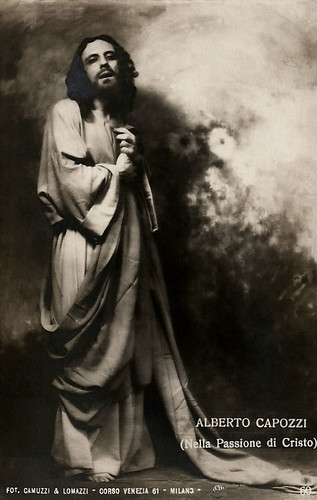
Italian postcard by Ed. A. Traldi, Milano, no. 69. Photo: Camuzzi & Lomazzi, Milano. Alberto Capozzi in the play 'La Passione di Cristo' (1924). The retro marks a stamp 'Bonomelli, Milano. Palazzo dello Sport, La Passione di Cristo, 1924'.
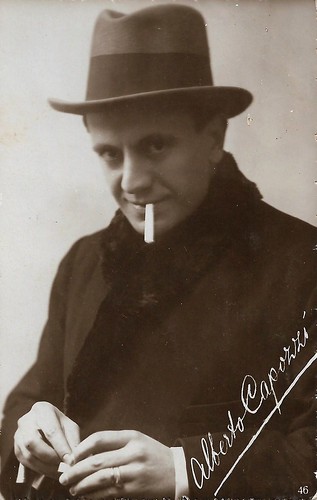
Italian postcard by Ed. A. Traldi, Milano, no. 46.
Wanted: major film actor
Alberto Angelo Capozzi was born in Genova, Italy in 1886. He was the son of ship owner Pietro Capozzi and Emanuela Causa. He spent his childhood in Sestri Ponente, and at the behest of his father he attended seminary but wasn’t very convinced of this imposed vocation. Meanwhile, he discovered the existence of dramatic societies, like so many others. He began to play, fell in love with the craft, and demanded his parents to fall in love with it as well.
At sixteen, he managed to get enlisted by comedian Novelli Vidali and felt like he was in heaven. When he informed his father, the latter did not even comment on it, but went up to the comedian and broke up the enlisting and the stage future of his son. But Alberto didn’t give up and so, at seventeen he entered a stage company managed by a certain Musella, which he soon left for the more prestigious Talli-Borelli company, run by Virginio Talli, Lyda Borelli and Emma Grammatica.
In 1909, he read a newspaper ad in Il piccolo Faust, "Wanted: major film actor." Capozzi wrote to Arturo Ambrosio, the man of the ad, and got an invitation to come to Turin. Ambrosio received him together with Luigi Maggi, artistic director of the company, and they made him try a tragic death; at the time, the screen test had not been born yet, so directors judged by the eye. When the test was over, Ambrosio offered him a contract at 300 lire a month. Alberto accepted with evident enthusiasm. A few days later he acted in his first film, the historical film Spergiura!/The False Oath (Arturo Ambrosio, Luigi Maggi, 1909). He played a hussar, who courts a married lady and is walled up in a room. The film was a liberal adaptation of La Grande Bretêche by Honoré de Balzac and was an international success. It was the first of the Serie d’Oro (Golden Series), a series of prestigious historical productions by Ambrosio, which often starred Capozzi and his female co-star from Spergiura!, Mary Cleo Tarlarini.
In the following years, Capozzi acted in countless short films. These included the epics Nerone/Nero (Luigi Maggi, 1909) with Capozzi as the Roman emperor, Didone abbondanata/Dido Forsaken by Aeneas (Luigi Maggi, 1910) with Capozzi as Aeneas, Lo schiavo di Cartagine/The Slave of Carthage (Arturo Ambrosio, Luigi Maggi, Roberto Omegna, 1910) which clearly precedes the plot of the epic Cabiria, and La Vergine di Babilonia/The Virgin of Babylon (Luigi Maggi, 1910) with Mary Cleo Tarlarini in the title role.
Other films were the Western La cintura d’oro/The Golden Belt (1911), the Napoleonic films Il debito dell’Imperatore/The Emperor's Debt (Luigi Maggi, 1911) and Il granatiere Roland/Grenadier Roland (Luigi Maggi, 1911), the Gustave Flaubert adaptation Salambò/Salambo (Arturo Ambrosio, 1911), and the Risorgimento set drama Nozze d’oro (Luigi Maggi, 1911). All were part of the Serie d’Oro. Nozze d’oro even won first prize at the Turin International Film Contest in 1911. Ambrosio seemed satisfied, raising Capozzi’s salary first to 500, then to 800 lire a month.
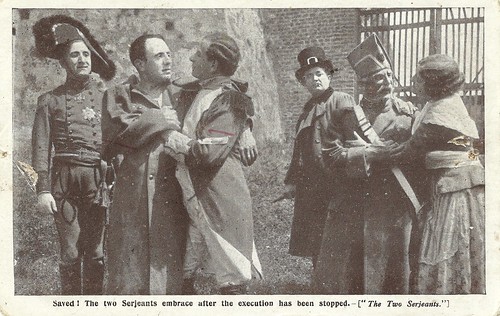
British postcard. Photo: Alberto Capozzi and Umberto Paradisi embrace in the Ambrosio production I due sergenti/The two Sergeants (Eugenio Perego, 1913).
The plot is about Captain Derville (Capozzi) who is unjustly accused of theft. He has to leave his wife and children and he disguises himself as a peasant named William. Because of his bravery during the Napoleonic wars he is appointed sergeant. He bonds with Sergeant Robert (Paradisi) but the jealous aide-de-camp Valmore (Giovanni Enrico Vidali), in love with Robert's fiancee Laura, plots to have both sergeants killed. When the two men transgress a quarantine in a time of plague, they are court-martialled and William has to die. William begs to say goodbye once more to his wife and children. Robert sacrifices himself to die instead if he doesn't return; Valmore doesn't mind this proposal. The evil Valmore even plots to delay William's return, but in the nick of time William returns, Robert is saved and the evil plotter is unmasked and condemned himself.

Spanish collectors card (cromo, minicard) by Chocolat Imperiale, Barcelona, card 5 of 6. Photo: J. Verdaguer, Barcelona / David-Karenne Film. Diana Karenne and Alberto Capozzi in the Italian silent film Justice de femme! (Diana Karenne, 1917), based on the novel by Daniel Lesuer.
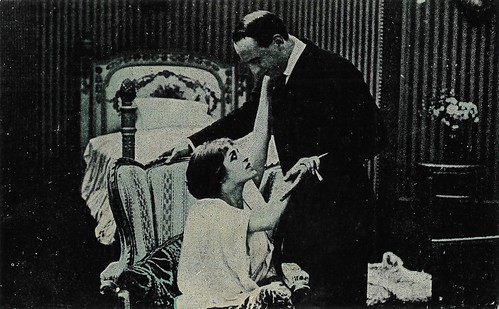
Spanish collectors card (cromo, minicard) by Chocolat Imperiale, Barcelona, card 6 of 6. Photo: J. Verdaguer, Barcelona / David-Karenne Film. Diana Karenne and Alberto Capozzi in the Italian silent film Justice de femme! (Diana Karenne, 1917), based on the novel by Daniel Lesuer.
Is it true that you gain 1200 lire a month?
In addition to these prestige films, Alberto Capozzi also acted for Ambrosio in several more modest modern short dramas. Examples are Alibi atroce/Truth Beyond Reach of Justice (Luigi Maggi, 1910), Il brutto sogno di una sartina/Alice's Awful Dream (N.N., 1911), and La tigre/The Human Tiger (Luigi Maggi, 1911). He could also be seen in historical shorts, like L’ostaggio/The Hostage (Luigi Maggi, 1909), Il corriere dell’imperatore/The Emperor's Messenger (Luigi Maggi, 1910), and La pena del taglione/The Law of Retaliation (N.N., 1911). He even did romantic comedies such as Stratagemma d’amore/Love Tricks (N.N., 1910) with Gigetta Morano, and Il tramezzo/The Wall Partition (N.N., 1911) with Mary Cleo Tarlarini.
In 1911, the film company Pasquali grabbed Alberto away from Ambrosio, raising his salary to 1200 lire a month. Students stopped Capozzi on the street: “Is it true that you gain 1200 lire a month?” That year the long feature broke through, and while Capozzi already had acted in early features at Ambrosio such as L’ultimo dei Frontignac/The Last of the Frontignacs (Mario Caserini, 1911), he continued to do even more so at Pasquali in L’amore dello chauffeur/The love of the chauffeur (N.N., 1911) with Lydia De Roberti, Sui gradini del trono/On the Steps of the Throne (Ubaldo Maria Del Colle, 1912), and Bianco contro negro/The Iron Fist (Ubaldo Maria Del Colle, 1913), which, despite what IMDb writes, has nothing to do with William Shakespeare's 'Othello' but with a white and a black boxer.
In 1914 Capozzi moved towards adventure and action features, often with co-stars like Cristina Ruspoli. Examples are Il supplizio dei leoni/A Journalist's Adventure (Luigi Mele or Eugenio Perego, 1914), and La maschera che sanguina/The Mask that Bleeds (Pier Angelo Mazzolotti, 1914). In addition to these features, Capozzi acted in many shorts at Pasquali, mainly in the years 1912-1913.
Capozzi’s name and face became well-known all over the globe. Meanwhile, he continued to work at Ambrosio in 1912 but now as co-writer of the comedy Santarellina/Mam'selle Nitouche (Mario Caserini, 1912) starring Gigetta Morano, and the historical films Parsifal (Mario Caserini, 1912) and Siegfried (Mario Caserini, 1912).
From America and France to Russia, Poland and Africa, Alberto Capozzi was recognised as a famous film star, having millions of loyal admirers and swooning female fans. His films made crazy grosses, especially La Rosa Rossa/The Red Rose of the Apache (Luigi Maggi, 1912) with Mario Bonnard. With the gains of just that film, Ernesto Maria Pasquali supposedly could build his new studios. Alberto received hundreds of letters from fans which he didn’t read but passed on to director Nino Oxilia, who responded to the thousands. Meanwhile, Gaumont called him to Paris and offered him a contract for 60,000 lires per year. But Pasquali offered him the same salary and Capozzi stayed in Turin.

Italian postcard by IPA CT Duplex, no. 4038 Photo: Film Soc. An. Ambrosio, Torino. Publicity still for Il romanzo di Maud (Diana Karenne, 1917). Caption: "Maud, don't play with my passion", her lover Giuliano implores her (Diana Karenne).
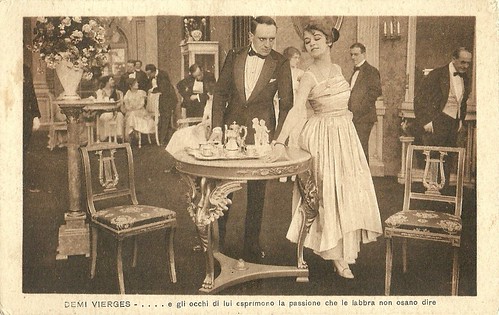
Italian postcard by IPA CT Duplefoto, no. 4041. Photo: Film Società Anonima Ambrosio, Torino. Diana Karenne in the Italian silent film Il romanzo di Maud a.k.a. Demi-vierges (Diana Karenne, 1917), based on Marcel Prévost's novel Demi-vierges, and directed by Diana Karenne herself. The film stars Karenne as Maud, while Alberto Capozzi plays Maxime and Francesco Cacace acts as Julien.

Spanish collectors card, no. 4. Chocolat Imperiale. Imp. Bayer Hnos. y C.a. Chromophotography. "El drama de una noche", the Spanish release title of the Italian melodrama Il dramma di una notte/The Drama of One Night aka Una notte a Calcutta (Mario Caserini, 1918), starring Lyda Borelli and Alberto Capozzi, was distributed in Spain during WWI by the company José Montanola, Barcelona.
Huge crowds waited for him with music
After the First World War broke out, Italy remained neutral at the start. Alberto Capozzi continued at Pasquali in films like Amore e cospirazione/Love and Conspiracy (Giovanni Enrico Vidali, 1915). In the same year, however, he must have gone back to Ambrosio, where he had his own ‘Capozzi series’. Several productions of this series were judged insufficient action and adventure films, such as Il Tesoro della cattedrale (Arturo Ambrosio Jr., 1915).
The press praised the veristic and well-performed Gli emigranti/The Emigrants (Gino Zaccaria, 1915), which co-starred Nilde Bruno, Capozzi’s regular female co-star in those years. The Emigrants might have been a sign, as Capozzi was offered the possibility to form a dramatic company to tour South America. The company started with a contract for three months, but according to the site In Penombra, the tour was so successful that they stayed overseas for a year. In Argentina everyone knew Capozzi, huge crowds waited for him with music.
It is not exactly known when and how long Capozzi stayed abroad, as he made several films in 1916 in Italy as well. With Diana Karenne, he played in the Pasquali production Oltre la Vita, oltre la Morte/Beyond Life, Beyond Death (Ernesto Maria Pasquali, 1916). He acted in the Ambrosio film Straccetto/Rag (Filippo Costamagna, 1916), with Gigetta Morano and Elena Makowska. He also played in the Gladiator production Le rovine di un sogno/The Ruins of a Dream (Ugo De Simone, 1916). In 1917 Capozzi played one of his most memorable parts in the Ambrosio production Fiacre No. 13, which he co-directed himself with Gero Zambuto. The film was based on Xavier de Montépin’s classic story. Count George de Latour (Vasco Creti), a spendthrift and gambler, decides to kill his brother and nephew in order to inherit their money. He is helped by his lover Berta Varny (Elena Makowska) and the apache Gian Giovedi (Capozzi).
The Apache cannot kill the infant, so he hides it in an empty carriage, Fiacre No. 13. George and Berta enjoy their wealthy life until the boy has grown up and revenge takes place, with the help of Gian Giovedi. Berta is unmasked by the latter during a tableau vivant which reconstructs the fateful events. She kills herself, while George goes mad. The nephew is returned in possession of the riches stolen from him. While the first of the four episodes of the film was forbidden by the Italian censors, only the last episode remains, in a tinted version at the Cineteca Italiana. It was restored and presented at Il Cinema Ritrovato in 2001. In 1917 Capozzi also acted in three films starring Diana Karenne, and all three were directed by herself: La Damina di Porcellana/The Little Porcelain Lady, Justice de femme/Female Justice, and Il Romanzo di Maud/Semi Virgins. In 1918 he acted opposite Lyda Borelli and Livio Pavanelli in Borelli’s last film Una notte a Calcutta/A Night in Calcutta (Mario Caserini, 1918).
That year he also starred in a film directed by himself: La parabola di una vita/The Story of a Life (Alberto Capozzi, 1918). It is clear, however, that in the late 1910s, Capozzi’s performances were drastically reduced in number. In 1919-1922 he continued to act in films but played just a few roles per year. He often was the male counterpart of female stars: subsequently Mina D’Orvella, Bianca Stagno Bellincioni, Lucy Di San Germano aka Lucy Sangermano, and the Hungarian actress Maria Corda - then known as Antonia Korda. The films with San Germano and Corda were directed by Alfredo De Antoni, who co-acted as the younger man in these films, opposite Capozzi as the by-now older man. The scriptwriter for these films was the future director Nunzio Malasomma.

Italian postcard by Ed. UCI, no. 109. Photo: Unione Cinematografica Italiana. Alberto Capozzi and Marie Doro in the Italian slent film La principessa misteriosa/The Mysterious Princess (Herbert Brenon, 1920).

Italian postcard by Ed. A. Traldi, Milano, no. 27. Photo: Fontana.

Italian postcard by G. Ballerini & C. Editori, Florence.
But what an exciting one...
In 1920, Alberto Capozzi starred opposite Marie Doro in La principessa misteriosa/The Mysterious Princess by the Irish-American director Herbert Brenon. Possibly attracted by Maria Corda, Capozzi went to Austria in 1922 to act opposite Corda in Eine Versunkene Welt/A Vanished World (Alexander Korda, 1922) with Victor Varconi. He played a Habsburg archduke who enlists as an ordinary seaman. The film, based on the novel 'Serpoletto' by Lajos Bíró, was shown at the 2009 Pordenone Silent Film Festival.
In 1922 Capozzi acted in only one other film, but what an exciting one: La Casa sotto la neve/The Cabin Under the Snow (Gennaro Righelli, 1922). Capozzi plays a doctor, Giorgio Salviati, who falls in love with Maria (Maria Jacobini), though she has a little daughter Grazia and is waiting for her lover Roberto to get married. The jealous Salviati steals Grazia to get Maria to an isolated cabin in the mountains, where he menaces the poor woman. During a snowstorm, Roberto is just in time to save her. Even the incomplete print of the film is very impressive.
In 1924 Capozzi did his last silent film, Profanazione (Eugenio Perego, 1924), starring Leda Gys. The film was only released in 1926 after several cuts and had scarce distribution. In the mid-1920s Italian cinema was in crisis and in 1923 the UCI (Unione Cinematografica Italiana, a merger of former major companies like Ambrosio) went bankrupt. Capozzi entered the theatre company of Tatiana Pavlova, which marked the 'professional' stage debut of Vittorio De Sica. Capozzi was the first actor in the company of Pavlova, who experimented in Italy with bold conceptions of staging. In 1923, Capozzi appeared as a faded actor, both as a comic character in 'Miss Hobbs' by J.K. Jerome, at the Teatro Filodrammatici of Milan, and as a dramatic character in Romanzo by E. Sheldon, at the same theatre.
The following year, after having left Pavlova, Capozzi personified the Redeemer, chanting nobly the gentle words of the Gospel, in The Passion of the Christ by A. Colantuoni. The costly show was first staged at the Palazzo dello Sport in Milan, then at the Teatro Adriano in Rome, where it sold out. In 1927 he joined the Borelli-Bertrame company and, once again, aroused interest from the theatre audiences. N. Leonelli said that his diction, though he strove to purify it, was affected by his roots in Genoa. However, Capozzi would return to the cinema. During the early years of sound film (1929-1931), American productions were forbidden to be shown in Italy with English spoken dialogue. So scenes were added in which Italian actors, including Capozzi, said what had been said by the Americans up till then. Paramount invited him to Paris to do so in various films till 1932.
Then Alexander Korda led him to London. There Capozzi could have had a lot of work, but the political atmosphere became ever more tense, so he returned to Italy shortly before the war. In the early 1940s Capozzi was highly active in Italian sound cinema and played quite substantial parts in films like Marco Visconti (Mario Bonnard, 1941) starring Carlo Ninchi, La cena delle beffe/The Dinner of the practical jokes (Alessandro Blasetti, 1942) starring Amedeo Nazzari, and Nessuna torna indietro/Responsibility Comes Back (Alessandro Blasetti, 1943) with Valentina Cortese. Capozzi’s last part was in Alberto Lattuada’s La freccia nel fianco/The Arrow, starring Mariella Lotti. Shooting halted in September 1943 and was finished by Mario Costa after the liberation of Rome in 1944. The film was released after the death of Alberto Capozzi, who died in Rome in 1945. He was 58. All in all, he acted in over 130 films between 1909 and 1943.
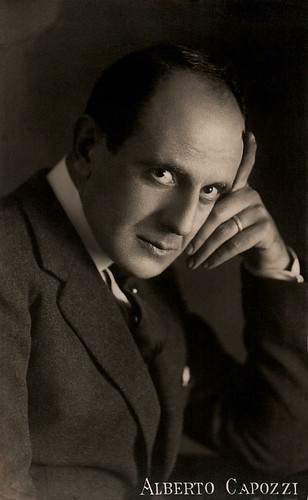
Italian postcard by Fotocelere, Torino.
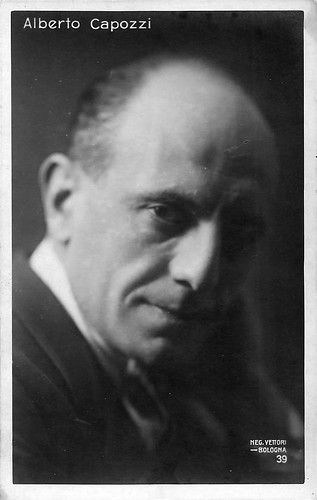
Italian postcard, no. 39. Photo: Vettori, Bologna.
Preview of Nerone (1909). Source: Harpodeon (YouTube).
Sources: Aldo Bernardini and Vittorio Martinelli (Il cinema muto italiano, 1905-1931 - Italian), Sempre in penombra (Italian), Treccani.it (Italian), Wikipedia (Italian) and IMDb.
This post was last updated on 9 September 2023.
No comments:
Post a Comment